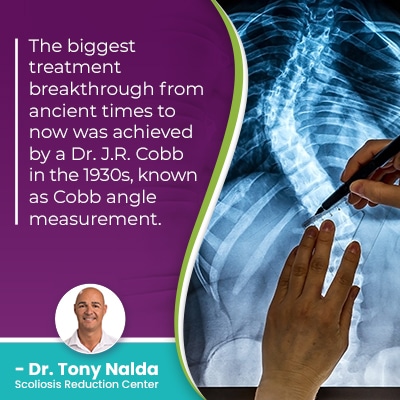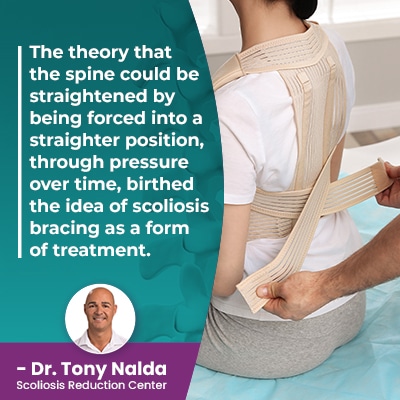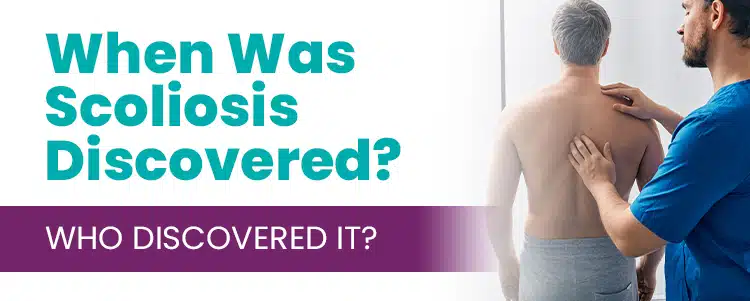It’s estimated that approximately close to seven million people are currently living with scoliosis in the United States alone, and as the leading spinal condition amongst school-aged children, awareness is key. While there are never treatment guarantees, scoliosis that’s detected and treated early can be more responsive to treatment.
Not only is scoliosis a highly-prevalent modern spinal condition, it’s been around since ancient times. Greek for bent or crooked, skolios, was first described by Hippocrates. Initially thought to be caused by poor posture, we’ve since learned that a true scoliosis is structural.
Our understanding of scoliosis, and treatment efficacy, has evolved alongside our growing understanding of the condition over the years, so let’s go back to the beginning, when scoliosis was first discovered.
When Was Scoliosis First Discovered?
Scoliosis is a spinal condition discovered in ancient Greece where it was first described and documented by Hippocrates (460-377 BC).
Greek for bent or crooked, skolios (scoliosis) means the development of an unnatural lateral spinal curvature with rotation.
Originally, the condition was thought to be caused by poor posture, but we’ve since learned that true scoliosis is structural: caused by a structural abnormality within the spine itself.
Scoliosis treatment has come a long way over the years. From being tied to wooden sticks and pulled and stretched painfully, patients have endured some interesting attempts to straighten a scoliotic spine.
Scoliosis introduces a lot of uneven forces to the spine, its surrounding muscles and nerves, and the entire body.

The biggest treatment breakthrough from ancient times to now was achieved by a Dr. J.R. Cobb in 1948, known as Cobb angle measurement.
What’s a Cobb Angle Measurement?
The Cobb angle measurement is known as the gold standard in the diagnosis and assessment of scoliosis and is determined during X-ray; X-ray imaging allows me to fully see what’s happening in and around the spine.
When the spine’s natural and healthy curves are in place, its vertebrae (bones of the spine) are aligned as they should be, but if an unhealthy curve develops, the spine becomes misaligned, and this disrupts the biomechanics of the entire spine.
A patient’s Cobb angle is determined by drawing lines from the tops and bottoms of the curve’s most-tilted vertebrae, and the intersecting angle is expressed in degrees.
The higher a patient’s Cobb angle, the more out of alignment the spine is, and the more severe a condition:
- Mild scoliosis: Cobb angle measurement of between 10 and 25 degrees
- Moderate scoliosis: Cobb angle measurement of between 25 and 40 degrees
- Severe scoliosis: Cobb angle measurement of 40+ degrees
- Very-severe scoliosis: Cobb angle measurement of 80+ degrees
Condition severity is a key condition variable that treatment plans are shaped around, and in the 1970s, bracing was introduced as a facet of scoliosis treatment.
Scoliosis Bracing
The theory that the spine could be straightened by being forced into a straighter position through pressure over time birthed the idea of scoliosis bracing as a form of treatment.
In the early 1970s, it was discovered that a brace could be used to manage scoliosis progression by Ambroise Paré.

The theory behind bracing is that it can be used to apply pressure to the spine to force it into a better position, alignment, and improve posture.
The concept of bracing had been around for many years prior, but Paré was the first to apply bracing to children with unnatural spinal curves, and also the first to prescribe them for continuous use until skeletal maturity was reached.
To this day, corrective bracing is known as particularly effective on growing spines, and works by pushing the spine into a corrective position, rather than traditional bracing that squeezes the spine unnaturally, known to weaken it over time.
Just like there are different scoliosis treatment options that can produce different potential outcomes, not all scoliosis braces are created equal, and while traditional bracing has the main goal of stopping progression, corrective bracing has the goal of augmenting corrective results.
Scoliosis Treatment Options: Surgical vs Non-surgical
The first attempts at scoliosis treatment in the ancient world involved trying to support the spine by tying patients to sticks; this was the precursor of bracing, and also spinal fusion surgery that attaches rods with screws to the spine to hold it in place.
The traditional response to a scoliosis diagnosis is to watch and wait to see if a condition gets worse, but as a progressive condition, virtually all cases of scoliosis are going to get worse over time.
Also, it’s important to understand that as scoliosis progresses, it gets more complex to treat as the spine becomes increasingly rigid with progression, and the body has more time to adjust to the presence of an unnatural spinal curve.
In addition, increasing spinal rigidity can make it difficult for some patients to perform certain therapeutic exercises as part of treatment.
Traditional scoliosis treatment involves bracing, but traditional scoliosis braces are limited in their potential efficacy because they only address scoliosis as a 2-dimensional condition, ignoring its rotational component.
When/if a patient progresses into the severe classification, they become surgical candidates and are commonly funneled towards spinal fusion surgery; the issue I have with this is that little was done in an attempt to prevent this type of progression beforehand.
Spinal fusion surgery involves fusing the curve’s most-tilted vertebrae into one solid bone and attaching rods to the spine with screws to hold it in place; however, hardware attached is permanent, and this approach can eliminate progression, but it can also reduce the spine’s natural flexibility and range of motion.
Non-Surgical Scoliosis Treatment
Here at the Scoliosis Reduction Center®, patients benefit from a more proactive response that starts treatment as close to the time of diagnosis as possible, rather than merely watching and waiting.
The reality is that traditional scoliosis treatment doesn’t have a strategy for treating scoliosis while mild, and many cases of scoliosis don’t need surgery.
Fortunately, for those who choose to forgo a surgical recommendation, or who simply want to try a less-invasive form of treatment first, my conservative chiropractic-centered treatment approach has produced some impressive results.
Through an integrative approach, I combine multiple different types of treatment so conditions can be impacted on every level: condition-specific chiropractic care, physical therapy, corrective bracing, and rehabilitation.
As our understanding of scoliosis as mainly caused by poor posture evolved into understanding that as a structural condition, scoliosis was caused by a structural abnormality within the spine itself, chiropractic care was applied as a means of impacting scoliosis on a structural level.
Through a series of chiropractic techniques and adjustments, I can work towards a curvature reduction by adjusting the position of the curve’s most-tilted vertebrae, at its apex, back into alignment with the rest of the spine.
Once I start to see the kind of structural results needed, I can shift the focus to increasing core strength, improving posture, and addressing any related muscle imbalance through physical therapy.
Corrective bracing can also help augment corrective treatment results by pushing the spine into a corrective aligned position and is particularly effective on growing spines.
Rehabilitation is the final ongoing phase of treatment that involves a series of custom-prescribed home exercises to further stabilize and heal the spine for long-term sustainable treatment results.
Conclusion
Scoliosis was first described and documented in ancient Greece by Hippocates (460 – 377 BC).
Scoliosis treatment has come a long way since ancient times; from patients with crooked spines being tied to wooden sticks, pulled, and stretched, treatment has evolved to include two main options: a surgical or non-surgical response.
For those who commit to a traditional treatment approach, spinal fusion surgery, when successful, can prevent future progression, but the way it’s achieved, through invasive surgery, can cost the spine in terms of its overall health, strength, and function.
The non-surgical treatment approach is known as conservative, chiropractic-centered, and/or functional treatment because it addresses scoliosis in a way that preserves as much of the spine’s natural strength and function as possible.
Here at the Scoliosis Reduction Center®, I combine chiropractic care, physical therapy, corretie bracing,and rehabilitation so conditions can be impacted on every level.
As a progressive condition, sometimes when treatment is started can be as important as the type of treatment applied, and the best time to start scoliosis treatment is always now.
While there are never treatment guarantees, with scoliosis that’s diagnosed and addressed early in its progressive line, there are fewer limits to what can be achieved; it’s far simpler to proactively work towards preventing progression and increasing condition-effects, than it is to attempt to work towards reversing those effects once they’ve developed.




